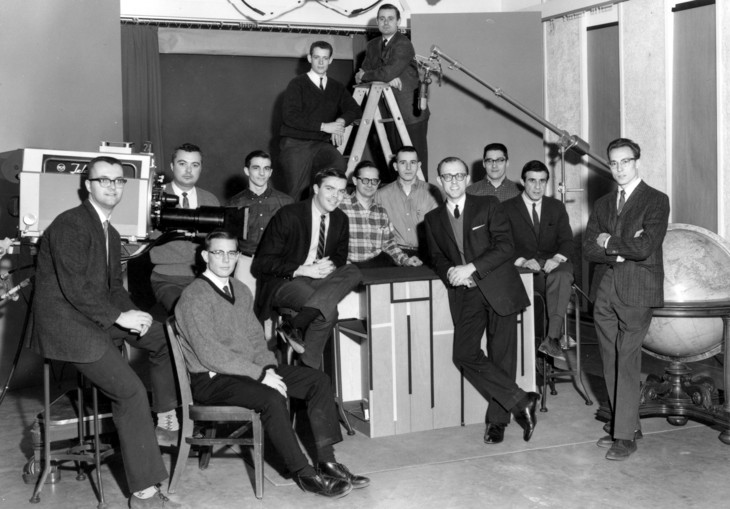Over-the-air television came to Centre County on September 15, 1949, as WJAC began “telecasting” from Johnstown. Originally assigned to channel 13, WJAC switched in 1955 to channel 6, a more favorable frequency. WGAL, in Lancaster, originally channel 4, went on the air on March 18, 1949, although its signal was not powerful enough at the time to reach into the county. In 1952 it was permitted to increase its power, extending its reach; it also moved to channel 8.
On March 1, 1953, WFBG in Altoona began operations on channel 10, changing its call letters in 1972 to WTAJ. Other regional stations that began in the early 1950s included two Harrisburg stations — WHP, channel 21, and WTPA, channel 27 — and three Scranton-Wilkes Barre stations – WNEP, channel 16; WDAU, channel 22; and WBRE, channel 28.
The lower numbered channels (lower radio frequencies), such as 6 and 8, tend to travel farther than channels such as 11 or 13. Nonetheless, distance and mountainous terrain made reception of any of these early TV signals a challenge for many county residents. They needed a fortunate location or a tall antenna. The high cost of early television sets also inhibited television’s popularity, and in 1950 only 40 homes in the State College area, about 1.4 percent of all homes, had a TV set.

Enterprising residents bought “boosters,” electronic devices that amplify the weak over-the-air signals picked up on their rabbit-ear or rooftop antennas. Some residents extended their amplified antenna wire to a neighbor’s house, sharing the TV experience. That concept led to cable television, the commercial application of taking a TV signal out of the air with a tall antenna, amplifying it, and sending it out into neighborhoods via a cable. It was then called Community Antenna Television (CATV), and the county hosted some of the nation’s first CATV systems.
Beginning as the Central Pennsylvania Corp., a group of Penn State engineers built a CATV system in Bellefonte in 1951, offering WJAC and expanding to WFBG in 1953. At the same time, the group started a sister system in State College, later combining the two as Centre Video Corp. It grew into surrounding communities, including Boalsburg, Lemont, Port Matilda, and Stormstown. By the late 1950s, the systems were carrying WGAL (then affiliated with NBC), WNEP (ABC), WDAU (CBS), WJAC (NBC), and WFBG (CBS and ABC). A subscriber could have the service installed for $5 and paid a $4.50 monthly fee.
Similar systems were built by others in Millheim (1955), Philipsburg (1959), and Snow Shoe (1957). The Millheim TV Transmission Line was subscriber owned. It cost $135 for installation but there was no monthly fee. The Philipsburg-Moshannon Valley TV Cable Company, with its antenna on an elevated location on the Allegheny Plateau, could capture signals from distant locations and provided subscribers with programming from KDKA and WTAE in Pittsburgh. By the mid-1950s, more than 1,000 county homes were on the cable, allowing viewers to tune in to prime-time favorites like I Love Lucy (CBS) on Mondays, The Milton Berle Show (NBC) on Tuesday, Dragnet (NBC) on Thursdays, and The Ed Sullivan Show (CBS) on Sundays.
Penn State had been a leader in the development and promotion of educational broadcasting since the earliest days of radio. The university extended that mission with the opening of its own noncommercial TV station, WPSX, channel 3, on March 1, 1965. (It changed its call letters to WPSU in 2005.) The station was licensed to Clearfield, where its transmitter was located, but Penn State maintained offices and studios on the campus. Early programming reflected the university’s goal of educational outreach — the WPSX call letters stood for Penn State Extension — and its shows included Facets of Cultural Geography and Patterns in Arithmetic.

In the 1960s and 1970s, TV became increasingly available to residents as the CATV systems grew. By the early 1970s, more than 90 percent of homes across the county had a television set, and those subscribing to cable service could receive a dozen channels, including stations such as WPIX and WOR in New York City. In 1975, the creation of a national system of satellite-distributed cable programming brought new choices to Centre County viewers, including the pay movie service Home Box Office (HBO). By the mid-1980s a subscriber could access C-SPAN, CNN, MTV, Nickelodeon, or ESPN.
The 1980s also brought two new broadcast stations to the county. On August 7, 1986, WATM, channel 23 in Altoona, which had existed in a variety of forms since 1974, relaunched as an ABC affiliate. And WWCP, channel 8 in Johnstown, began broadcasting on October 13, 1986, soon becoming the regional affiliate of the country’s fourth national TV network, Fox Broadcasting. The Federal Communications Commission had made TV licenses available for State College for years, but it was not until 2007 that channel 29, WHVL (“Happy VaLley”), a MyNetworkTV affiliate, began operations as the county’s the first commercial TV broadcaster.
The county has many rural residents, and the cable TV wire did not extend to isolated homes and farms. Beginning in the mid-1990s, however, those viewers could subscribe to a satellite broadcast service, like DirecTV or Dish, and receive all the programming their friends in town enjoyed on cable. Today, cable, satellite and broadband service provides almost unlimited television programming, from traditional sources and from across the internet, to nearly every home in the county.
Patrick Parsons
Sources:
O’Toole, Kathleen. “The First Five Years: The Birth and Development of Public Television at the Pennsylvania State University” (MA thesis, Penn State University, 2005).
Parsons, Patrick. Blue Skies: A History of Cable Television. Philadelphia: Temple University Press, 2008.
Television Factbook. Washington, DC: Television Digest, Inc., various years.
U.S. Dept. of Commerce, Bureau of the Census, Census of Housing: 1950, vol. 1, part 5. Washington DC: GPO, 1953, Pennsylvania Table 20, pp. 38-49.
First Published: July 22, 2021
Last Modified: January 1, 2024
